Maximizing Upconversion Luminescence of Co-Doped CaF₂:Yb, Er Nanoparticles at Low Laser Power for Efficient Cellular Imaging
Abstract
:1. Introduction
2. Results and Discussion
2.1. Structural and Vibrational Properties
2.2. NIR Absorbance and Photoluminescence (PL) Characteristics
2.3. Light Scattering and Upconversion Luminescence Imaging Properties
3. Experimental Section
3.1. Materials and Methods
3.2. Synthesis of Co-Doped CaF2:Yb3+, Er3+ UCNPs
3.3. Characterization
4. Conclusions
Supplementary Materials
Author Contributions
Funding
Institutional Review Board Statement
Informed Consent Statement
Data Availability Statement
Acknowledgments
Conflicts of Interest
References
- Naher, H.S.; Al-Turaihi, B.A.H.; Mohammed, S.H.; Naser, S.M.; Albark, M.A.; Madlool, H.A.; Al- Marzoog, H.A.M.; Turki Jalil, A. Upconversion Nanoparticles (UCNPs): Synthesis Methods, Imaging and Cancer Therapy. J. Drug Deliv. Sci. Technol. 2023, 80, 104175. [Google Scholar] [CrossRef]
- Wilhelm, S. Perspectives for Upconverting Nanoparticles. ACS Nano 2017, 11, 10644–10653. [Google Scholar] [CrossRef] [PubMed]
- Chen, B.; Wang, F. Emerging Frontiers of Upconversion Nanoparticles. Trends Chem. 2020, 2, 427–439. [Google Scholar] [CrossRef]
- Karimov, D.N.; Demina, P.A.; Koshelev, A.V.; Rocheva, V.V.; Sokovikov, A.V.; Generalova, A.N.; Zubov, V.P.; Khaydukov, E.V.; Koval’chuk, M.V.; Panchenko, V.Y. Upconversion Nanoparticles: Synthesis, Photoluminescence Properties, and Applications. Nanotechnol Russ. 2020, 15, 655–678. [Google Scholar] [CrossRef]
- Atulbhai, S.V.; Singhal, R.K.; Basu, H.; Kailasa, S.K. Perspectives of Different Colour-emissive Nanomaterials in Fluorescent Ink, LEDs, Cell Imaging, and Sensing of Various Analytes. Luminescence 2023, 38, 867–895. [Google Scholar] [CrossRef]
- Bala, W.A.; Benitha, V.S.; Jeyasubramanian, K.; Hikku, G.S.; Sankar, P.; Kumar, S.V. Investigation of Anti-Bacterial Activity and Cytotoxicity of Calcium Fluoride Nanoparticles. J. Fluor. Chem. 2017, 193, 38–44. [Google Scholar] [CrossRef]
- Bensalah, A.; Mortier, M.; Patriarche, G.; Gredin, P.; Vivien, D. Synthesis and Optical Characterizations of Undoped and Rare-Earth-Doped CaF2 Nanoparticles. J. Solid State Chem. 2006, 179, 2636–2644. [Google Scholar] [CrossRef]
- Rastogi, C.K. Up-Converting Lanthanide Ions Doped Fluoride Nanophosphors: Advances from Synthesis to Applications. In Handbook on Synthesis Strategies for Advanced Materials; Tyagi, A.K., Ningthoujam, R.S., Eds.; Indian Institute of Metals Series; Springer: Singapore, 2021; pp. 159–211. [Google Scholar] [CrossRef]
- Dubey, N.; Chandra, S. Upconversion Nanoparticles: Recent Strategies and Mechanism Based Applications. J. Rare Earths 2022, 40, 1343–1359. [Google Scholar] [CrossRef]
- Chen, B.; Wang, F. Combating Concentration Quenching in Upconversion Nanoparticles. Acc. Chem. Res. 2020, 53, 358–367. [Google Scholar] [CrossRef]
- Naccache, R.; Yu, Q.; Capobianco, J.A. The Fluoride Host: Nucleation, Growth, and Upconversion of Lanthanide-Doped Nanoparticles. Adv. Opt. Mater. 2015, 3, 482–509. [Google Scholar] [CrossRef]
- Wang, L.; Li, X.; Li, Z.; Chu, W.; Li, R.; Lin, K.; Qian, H.; Wang, Y.; Wu, C.; Li, J.; et al. A New Cubic Phase for a NaYF4 Host Matrix Offering High Upconversion Luminescence Efficiency. Adv. Mater. 2015, 27, 5528–5533. [Google Scholar] [CrossRef]
- Fu, J.; Zhang, X.; Chao, Z.; Li, Z.; Liao, J.; Hou, D.; Wen, H.; Lu, X.; Xie, X. Enhanced Upconversion Luminescence of NaYF4 :Yb, Er Microprisms via La 3+ Doping. Opt. Laser Technol. 2017, 88, 280–286. [Google Scholar] [CrossRef]
- Deng, X.; Dai, Y.; Liu, J.; Zhou, Y.; Ma, P.; Cheng, Z.; Chen, Y.; Deng, K.; Li, X.; Hou, Z.; et al. Multifunctional Hollow CaF2:Yb3+/Er3+/Mn2+-Poly(2-Aminoethyl Methacrylate) Microspheres for Pt(IV) pro-Drug Delivery and Tri-Modal Imaging. Biomaterials 2015, 50, 154–163. [Google Scholar] [CrossRef] [PubMed]
- Alexandrov, A.A.; Mayakova, M.N.; Voronov, V.V.; Pominova, D.V.; Kuznetsov, S.V.; Baranchikov, A.E.; Ivanov, V.K.; Lysakova, E.I.; Fedorov, P.P. Synthesis of upconversion luminophores based on calcium fluoride. Condens. Mater. Interface. 2020, 22, 3–10. [Google Scholar] [CrossRef]
- Ansari, A.A.; Yadav, R.; Rai, S.B. Physiochemical Properties of Greatly Enhanced Photoluminescence of Aqueous Dispersible Upconversion CaF2:Yb/Er Nanoparticles. Photochem. Photobiol. Sci. 2017, 16, 890–896. [Google Scholar] [CrossRef]
- Li, Z.; Zhang, Y.; Huang, L.; Yang, Y.; Zhao, Y.; El-Banna, G.; Han, G. Nanoscale “Fluorescent Stone”: Luminescent Calcium Fluoride Nanoparticles as Theranostic Platforms. Theranostics 2016, 6, 2380–2393. [Google Scholar] [CrossRef]
- Sarthou, J.; Aballéa, P.; Patriarche, G.; Serier-Brault, H.; Suganuma, A.; Gredin, P.; Mortier, M. Wet-Route Synthesis and Characterization of Yb:CaF2 Optical Ceramics. J. Am. Ceram. Soc. 2016, 99, 1992–2000. [Google Scholar] [CrossRef]
- Ginther, R.J. Sensitized Luminescence of CaF2:(Ce + Mn). J. Electrochem. Soc. 1954, 101, 248. [Google Scholar] [CrossRef]
- Teo, R.D.; Termini, J.; Gray, H.B. Lanthanides: Applications in Cancer Diagnosis and Therapy: Miniperspective. J. Med. Chem. 2016, 59, 6012–6024. [Google Scholar] [CrossRef]
- Yuan, D.; Li, W.; Mei, B.; Song, J. Synthesis and Characterization of Nd3+-Doped CaF2 Nanoparticles. J. Nanosci. Nanotechnol. 2015, 15, 9741–9745. [Google Scholar] [CrossRef]
- Hong, B.-C.; Kawano, K. Syntheses of CaF2:Eu Nanoparticles and the Modified Reducing TCRA Treatment to Divalent Eu Ion. Opt. Mater. 2008, 30, 952–956. [Google Scholar] [CrossRef]
- Zhao, J.; Zhu, Y.-J.; Wu, J.; Chen, F. Microwave-Assisted Solvothermal Synthesis and Upconversion Luminescence of CaF2:Yb3+/Er3+ Nanocrystals. J. Colloid Interface Sci. 2015, 440, 39–45. [Google Scholar] [CrossRef] [PubMed]
- Yin, W.; Tian, G.; Ren, W.; Yan, L.; Jin, S.; Gu, Z.; Zhou, L.; Li, J.; Zhao, Y. Design of Multifunctional Alkali Ion Doped CaF2 Upconversion Nanoparticles for Simultaneous Bioimaging and Therapy. Dalton Trans. 2014, 43, 3861. [Google Scholar] [CrossRef] [PubMed]
- Dolcet, P.; Mambrini, A.; Pedroni, M.; Speghini, A.; Gialanella, S.; Casarin, M.; Gross, S. Room Temperature Crystallization of Highly Luminescent Lanthanide-Doped CaF2 in Nanosized Droplets: First Example of the Synthesis of Metal Halogenide in Miniemulsion with Effective Doping and Size Control. RSC Adv. 2015, 5, 16302–16310. [Google Scholar] [CrossRef]
- Yu, Z.; Shi, J.; Li, J.; Li, P.; Zhang, H. Luminescence Enhancement of CaF 2 :Nd 3+ Nanoparticles in the Second near-Infrared Window for in Vivo Imaging through Y3+ Doping. J. Mater. Chem. B 2018, 6, 1238–1243. [Google Scholar] [CrossRef] [PubMed]
- Peternele, W.S.; Monge Fuentes, V.; Fascineli, M.L.; Rodrigues Da Silva, J.; Silva, R.C.; Lucci, C.M.; Bentes De Azevedo, R. Experimental Investigation of the Coprecipitation Method: An Approach to Obtain Magnetite and Maghemite Nanoparticles with Improved Properties. J. Nanomater. 2014, 2014, 682985. [Google Scholar] [CrossRef]
- Singh, P.; Upadhyay, C. Fine Tuning of Size and Morphology of Magnetite Nanoparticles Synthesized by Microemulsion. AIP Conf. Proc. 2018, 1953, 030051. [Google Scholar] [CrossRef]
- Xia, Z.; Du, P. Synthesis and Upconversion Luminescence Properties of CaF2 :Yb3+,Er3+ Nanoparticles Obtained from SBA-15 Template. J. Mater. Res. 2010, 25, 2035–2041. [Google Scholar] [CrossRef]
- Ansari, A.A.; Parchur, A.K.; Labis, J.P.; Shar, M.A.; Khan, A. Highly Hydrophilic CaF2:Yb/Er Upconversion Nanoparticles: Structural, Morphological, and Optical Properties. J. Fluor. Chem. 2021, 247, 109820. [Google Scholar] [CrossRef]
- Szczeszak, A.; Grzyb, T.; Nowaczyk, G.; Ekner-Grzyb, A. Emission Colour Changes in the CaF2 Sub-Microspheres Doped with Yb3+, Er3+ and Mn2+ Ions. J. Alloys Compd. 2020, 817, 152718. [Google Scholar] [CrossRef]
- Pedroni, M.; Piccinelli, F.; Passuello, T.; Giarola, M.; Mariotto, G.; Polizzi, S.; Bettinelli, M.; Speghini, A. Lanthanide Doped Upconverting Colloidal CaF2 Nanoparticles Prepared by a Single-Step Hydrothermal Method: Toward Efficient Materials with near Infrared-to-near Infrared Upconversion Emission. Nanoscale 2011, 3, 1456. [Google Scholar] [CrossRef]
- Zhang, B.; Zhang, Z.; Huang, B.H.; Qian, X.; Wang, J.Y.; Liu, R.; Ma, F.; Su, L. Tailoring Local Coordination Structure of the Er 3+ Ions for Tuning the up-Conversion Multicolor Luminescence. Opt. Express 2020, 28, 22218. [Google Scholar] [CrossRef] [PubMed]
- Balabhadra, S.; Reid, M.F.; Golovko, V.; Wells, J.-P.R. Influence of the Synthesis Method on Preferential Clustering of Yb3+ in CaF2:Yb3+/Er3+ Upconverting Nanoparticles. Opt. Mater. 2021, 112, 110736. [Google Scholar] [CrossRef]
- Gonçalves, J.M.; Bastos, A.R.N.; Ribeiro, S.J.L.; Carlos, L.D.; Longo, R.L.; Caiut, J.M.A.; Ferreira, R.A.S. Thermal Properties of Nanofluids Using Hydrophilic and Hydrophobic LiYF 4 :Yb/Er Upconverting Nanoparticles. Nanoscale Adv. 2024, 6, 1486–1496. [Google Scholar] [CrossRef] [PubMed]
- Birch, R.; Bruckbauer, J.; Gajewska, M.; Cios, G.; Pal, R.; MacKenzie, L.E. Influence of Polyvinylpyrrolidone (PVP) in the Synthesis of Luminescent NaYF4 :Yb,Er Upconversion Nanoparticles. Methods Appl. Fluoresc. 2023, 11, 034001. [Google Scholar] [CrossRef] [PubMed]
- Andresen, E.; Islam, F.; Prinz, C.; Gehrmann, P.; Licha, K.; Roik, J.; Recknagel, S.; Resch-Genger, U. Assessing the Reproducibility and Up-Scaling of the Synthesis of Er,Yb-Doped NaYF4-Based Upconverting Nanoparticles and Control of Size, Morphology, and Optical Properties. Sci. Rep. 2023, 13, 2288. [Google Scholar] [CrossRef]
- Wiesholler, L.M.; Frenzel, F.; Grauel, B.; Würth, C.; Resch-Genger, U.; Hirsch, T. Yb,Nd,Er-Doped Upconversion Nanoparticles: 980 Nm versus 808 Nm Excitation. Nanoscale 2019, 11, 13440–13449. [Google Scholar] [CrossRef]
- Cantelar, E.; Lifante-Pedrola, G.; Quintanilla, M.; Sanz-García, J.A.; Cussó, F. Spectroscopic Characterization of Er3+-Doped CaF2 Nanoparticles: Luminescence Concentration Quenching, Radiation Trapping and Transition Probabilities. J. Alloys Compd. 2023, 954, 170192. [Google Scholar] [CrossRef]
- Ramachandran, R.; Johnson-McDaniel, D.; Salguero, T.T. Formation and Scrolling Behavior of Metal Fluoride and Oxyfluoride Nanosheets. Chem. Mater. 2016, 28, 7257–7267. [Google Scholar] [CrossRef]
- Kotkowiak, M.; Piasecki, A.; Kotkowiak, M.; Buchwald, T. The Mechanism of Wear Reduction in the Ni-CaF2 Composite Material: Raman and Confocal Microscopy Insights. Materials 2022, 15, 5501. [Google Scholar] [CrossRef]
- Namagal, S.; Jaya, N.V.; Muralidharan, M.; Sumithra, S. Optical and Magnetic Properties of Pure and Er, Yb-Doped β-NaYF4 Hexagonal Plates for Biomedical Applications. J. Mater. Sci. Mater. Electron. 2020, 31, 11398–11410. [Google Scholar] [CrossRef]
- Wilhelm, S.; Hirsch, T.; Patterson, W.M.; Scheucher, E.; Mayr, T.; Wolfbeis, O.S. Multicolor Upconversion Nanoparticles for Protein Conjugation. Theranostics 2013, 3, 239–248. [Google Scholar] [CrossRef]
- Bezerra, C.D.S.; Valerio, M.E.G. Structural and Optical Study of CaF2 Nanoparticles Produced by a Microwave-Assisted Hydrothermal Method. Phys. B Condens. Matter 2016, 501, 106–112. [Google Scholar] [CrossRef]
- Hasabeldaim, E.H.H.; Swart, H.C.; Kroon, R.E. Luminescence and Stability of Tb Doped CaF 2 Nanoparticles. RSC Adv. 2023, 13, 5353–5366. [Google Scholar] [CrossRef]
- Chingo Aimacaña, C.M.; Pila, K.O.; Quinchiguango Perez, D.A.; Debut, A.; Attia, M.F.; Santos-Oliveira, R.; Whitehead, D.C.; Reinoso, C.; Alexis, F.; Dahoumane, S.A. Bimodal Ultrasound and X-Ray Bioimaging Properties of Particulate Calcium Fluoride Biomaterial. Molecules 2021, 26, 5447. [Google Scholar] [CrossRef]
- Morkoç, B.; Kahraman, A.; Yılmaz, E. Effects of the Oxide/Interface Traps on the Electrical Characteristics in Al/Yb2O3/SiO2/n-Si/Al MOS Capacitors. J. Mater. Sci. Mater. Electron. 2021, 32, 9231–9243. [Google Scholar] [CrossRef]
- Jayswal, S.; Ningthoujam, R.S.; Moirangthem, R.S. Observation of Stark Splitting in Micro Upconversion Photoluminescence Spectra of Polycrystalline Ln3+ Doped Y2O3 Microspheres. Nanotechnology 2022, 33, 335702. [Google Scholar] [CrossRef] [PubMed]
- Gainer, C.F.; Joshua, G.S.; De Silva, C.R.; Romanowski, M. Control of Green and Red Upconversion in NaYF4:Yb3+,Er3+ Nanoparticles by Excitation Modulation. J. Mater. Chem. 2011, 21, 18530. [Google Scholar] [CrossRef]
- Joshi, R.; Perala, R.S.; Shelar, S.B.; Ballal, A.; Singh, B.P.; Ningthoujam, R.S. Super Bright Red Upconversion in NaErF4 :0.5%Tm@NaYF4 :20%Yb Nanoparticles for Anti-Counterfeit and Bioimaging Applications. ACS Appl. Mater. Interfaces 2021, 13, 3481–3490. [Google Scholar] [CrossRef]
- Yu, S.; Zhi, Y.; Su, H. Hydrothermal Synthesis and Upconversion Properties of CaF2:Er3+/Yb3+Nanocrystals. J. Nanosci. Nanotech. 2014, 14, 3380–3386. [Google Scholar] [CrossRef]
- Xin, M. Color Tunable Upconversion Luminescence of Er3+ -Yb3+ Codoped KY3F10 Prepared by a Hydrothermal Treatment. Opt. Laser Technol. 2024, 170, 110271. [Google Scholar] [CrossRef]
- Bergstrand, J.; Liu, Q.; Huang, B.; Peng, X.; Würth, C.; Resch-Genger, U.; Zhan, Q.; Widengren, J.; Ågren, H.; Liu, H. On the Decay Time of Upconversion Luminescence. Nanoscale 2019, 11, 4959–4969. [Google Scholar] [CrossRef] [PubMed]
- Dutta, B.; Shetake, N.G.; Barick, B.K.; Barick, K.C.; Pandey, B.N.; Priyadarsini, K.I.; Hassan, P.A. pH Sensitive Surfactant-Stabilized Fe3O4 Magnetic Nanocarriers for Dual Drug Delivery. Colloids Surf. B Biointerfaces 2018, 162, 163–171. [Google Scholar] [CrossRef] [PubMed]
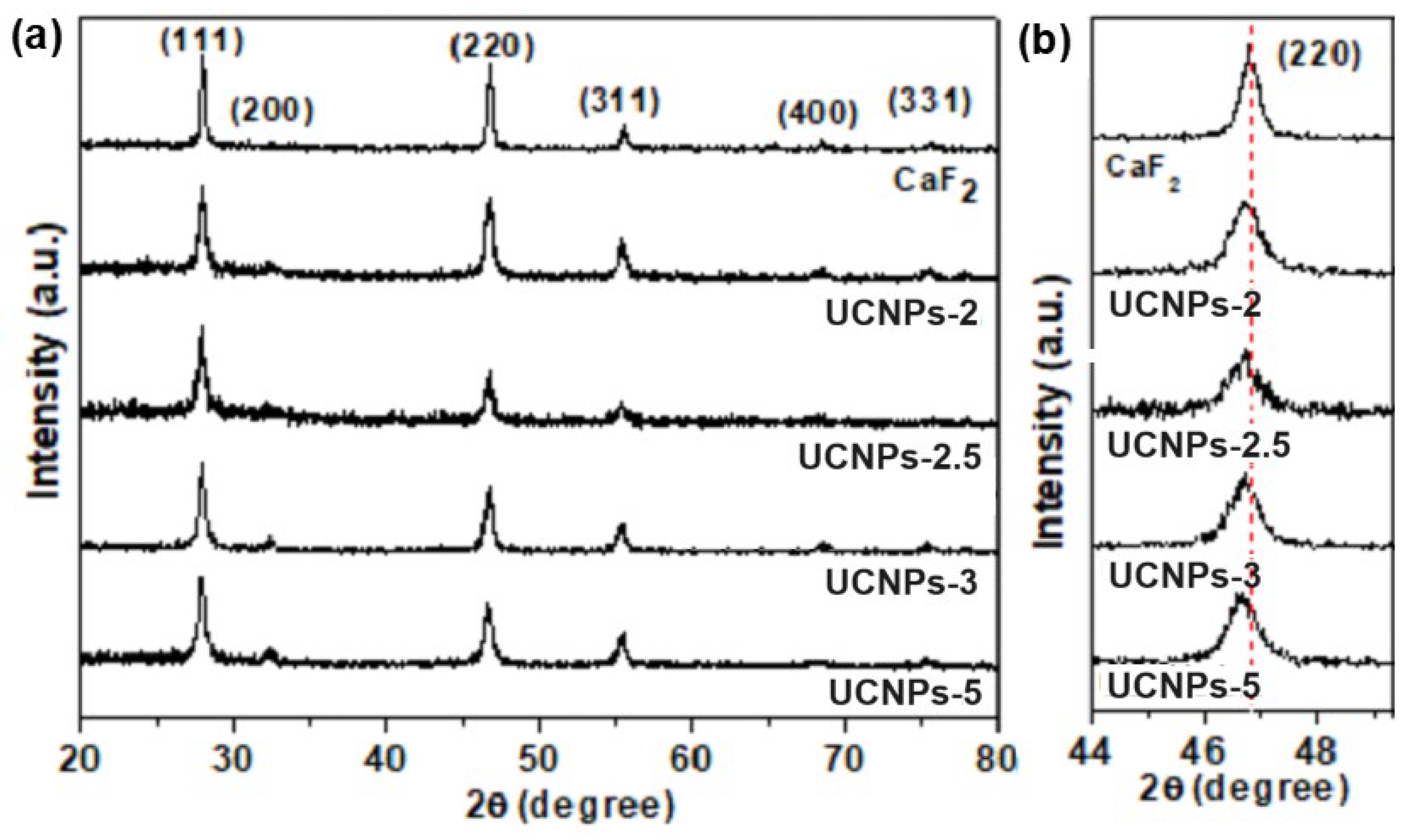
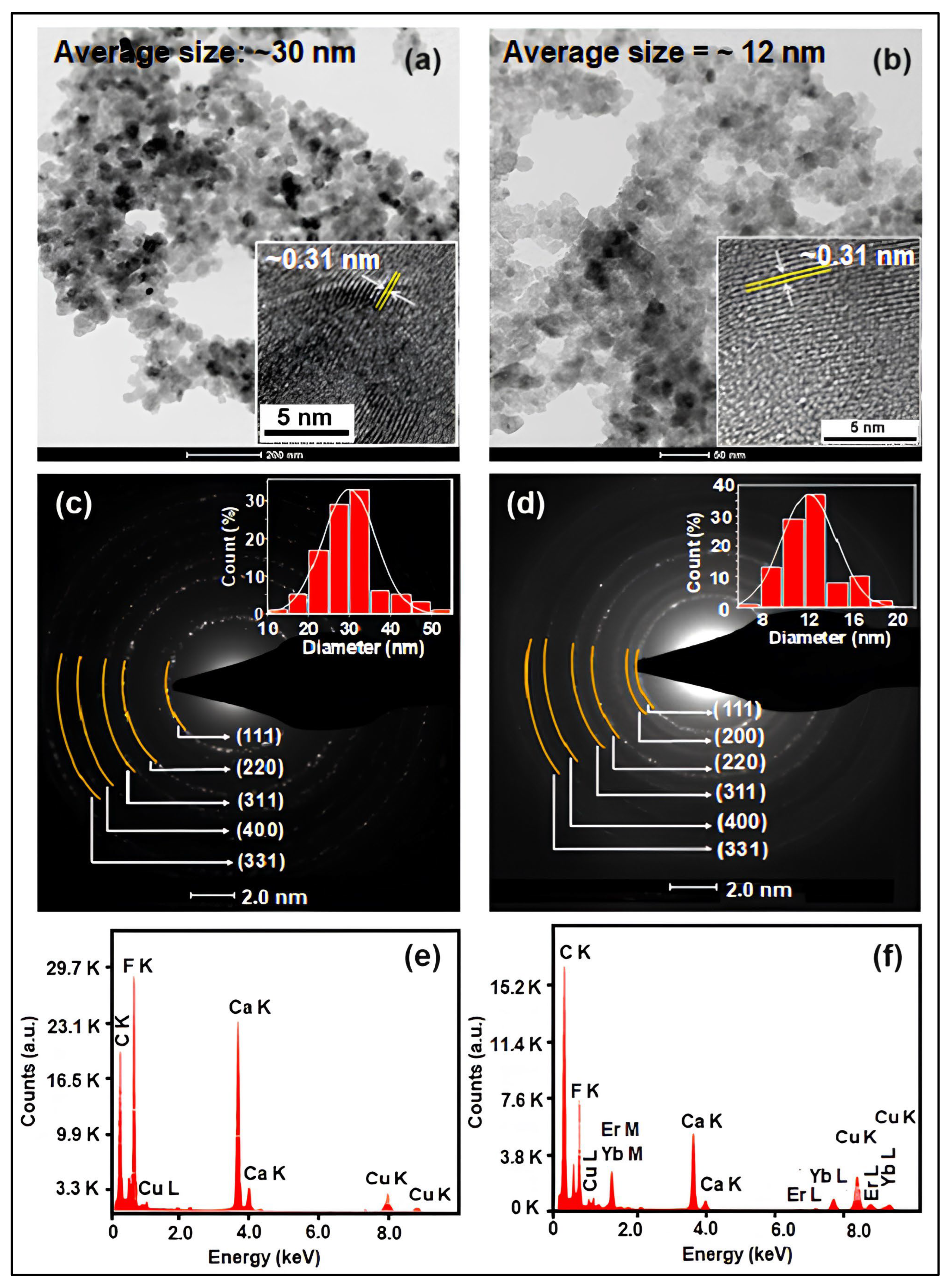
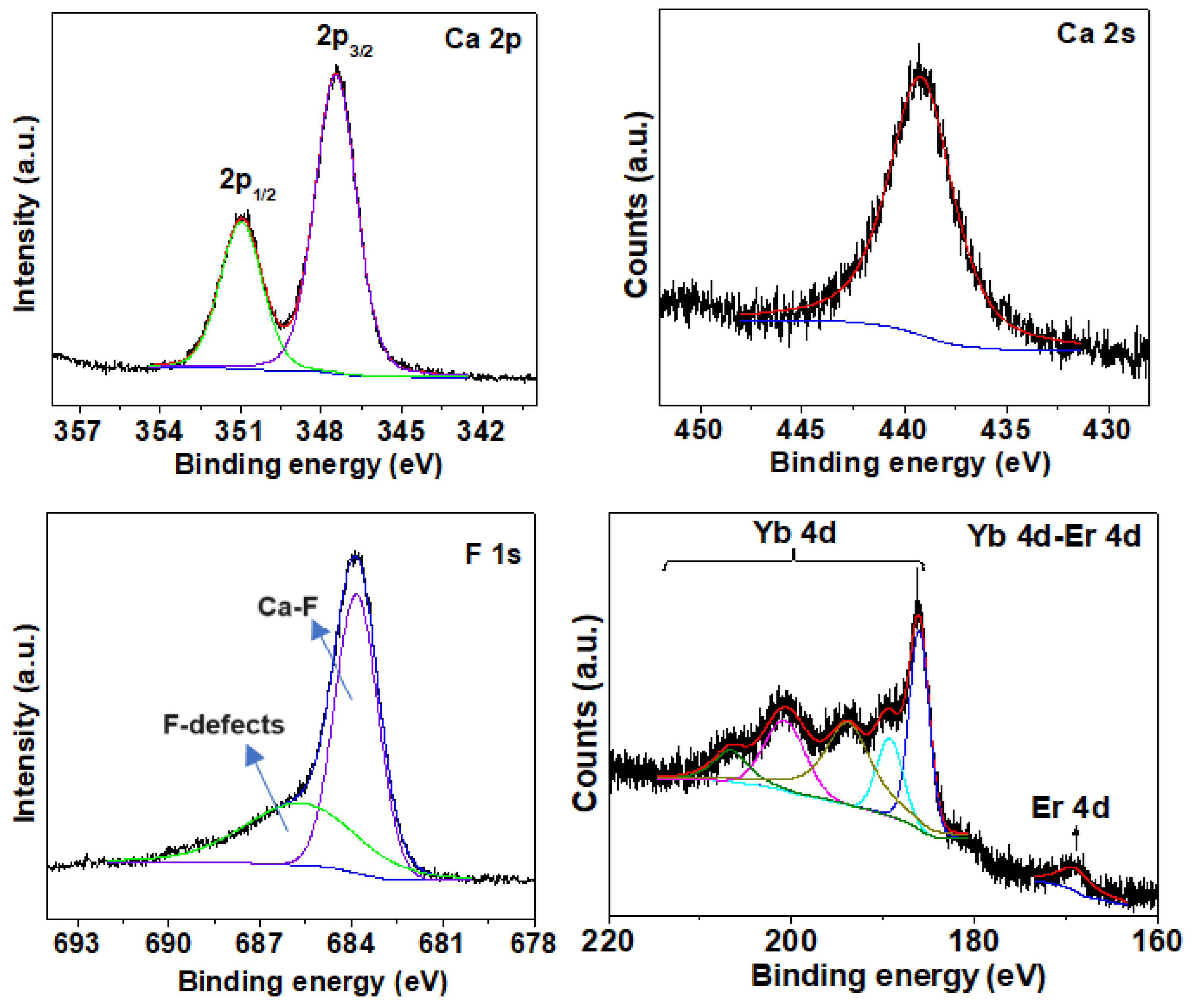

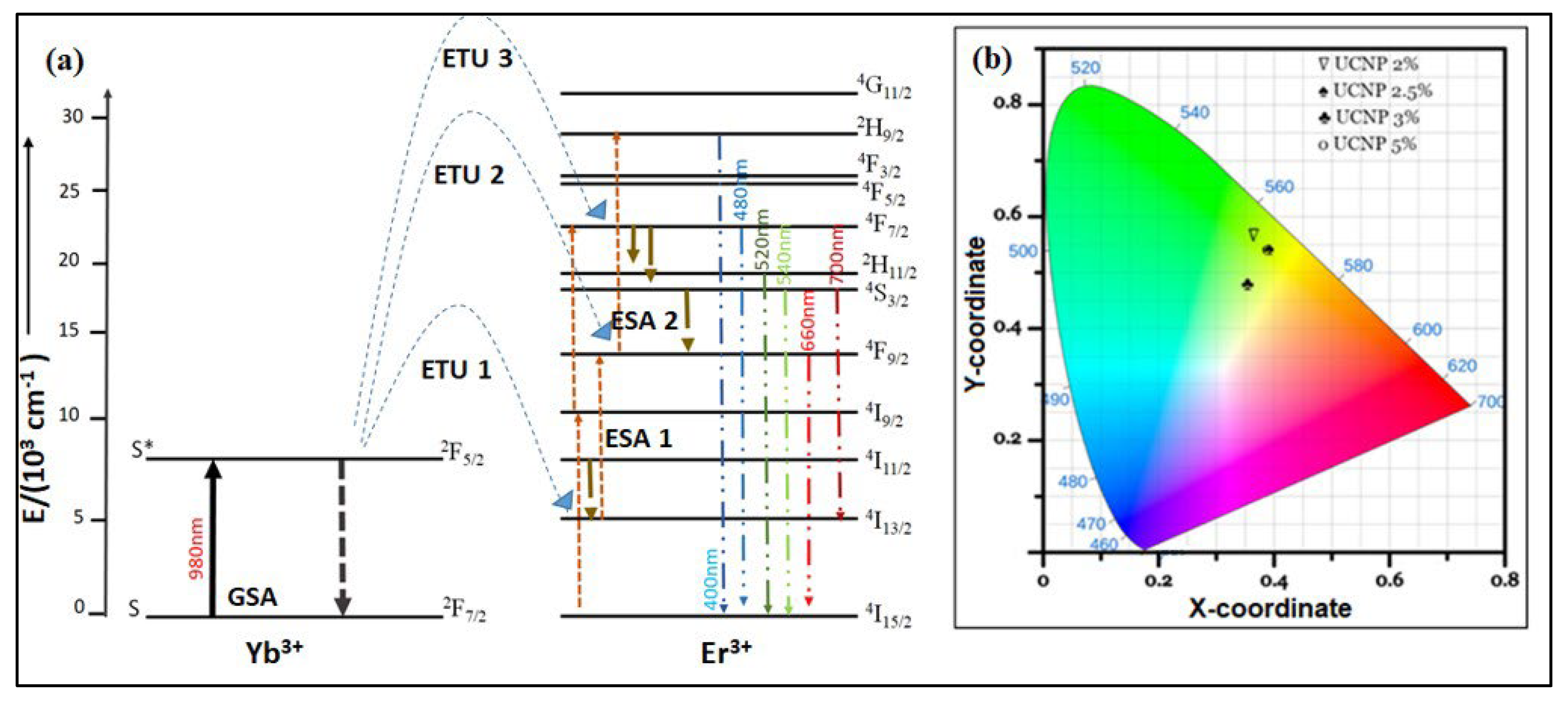
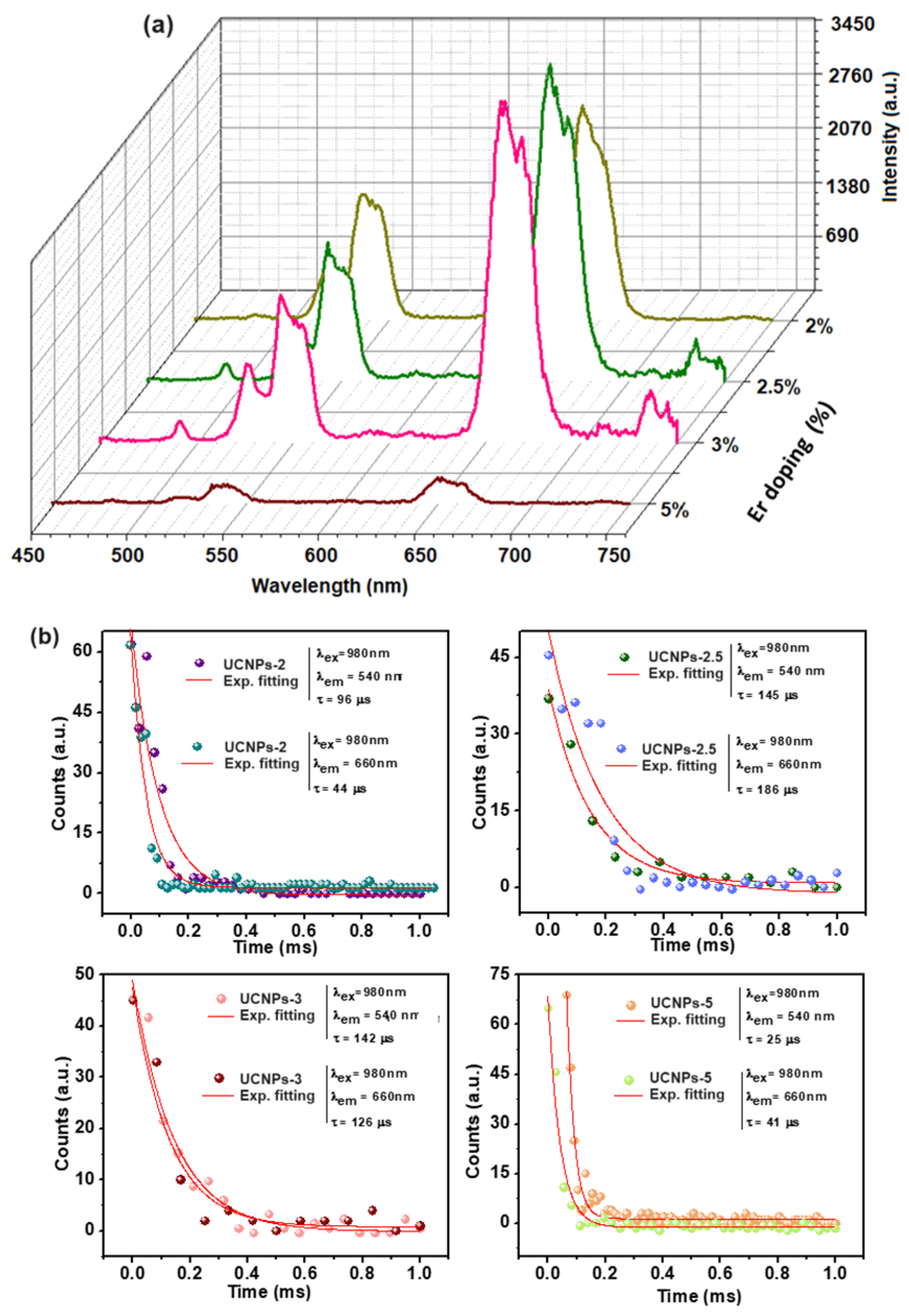
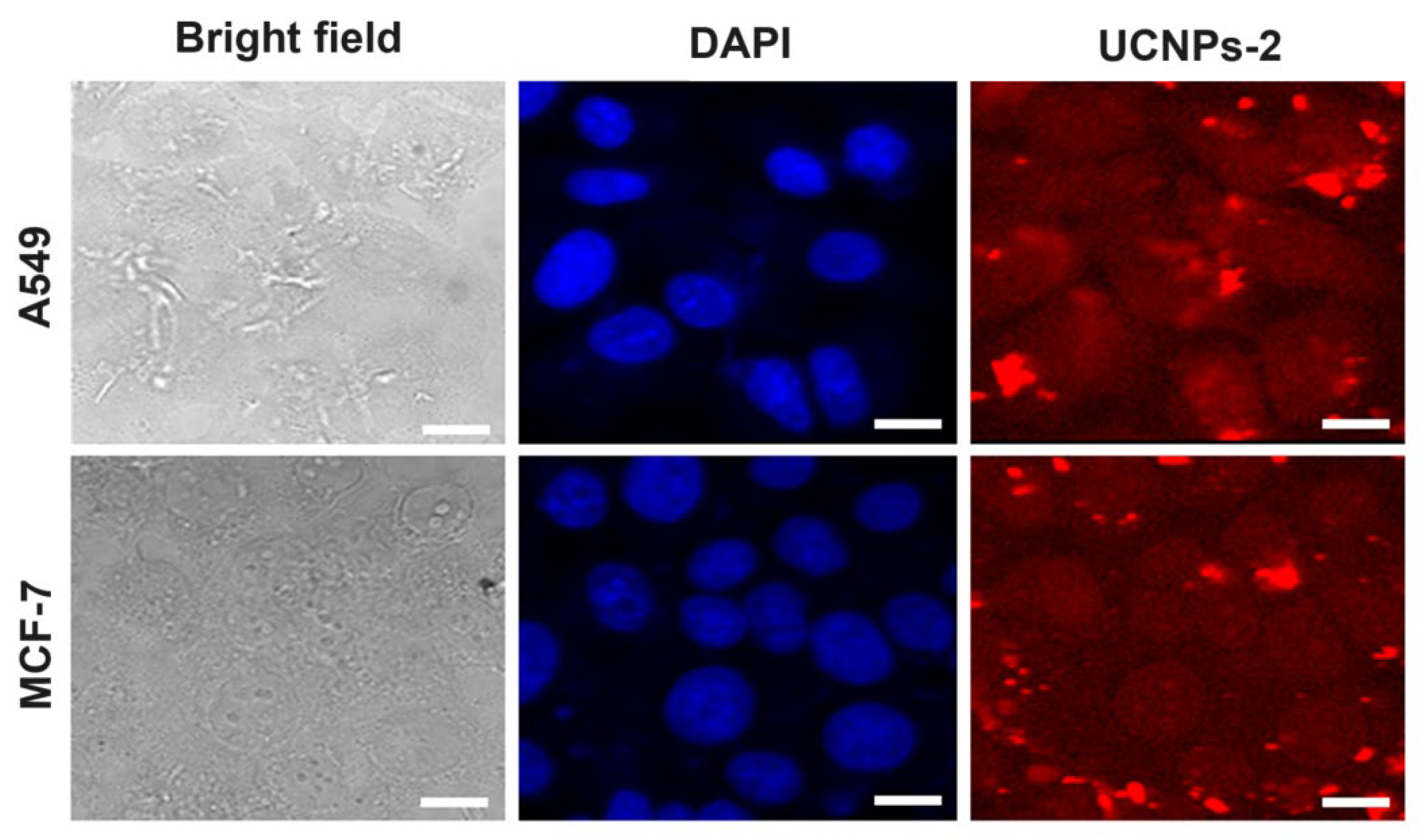
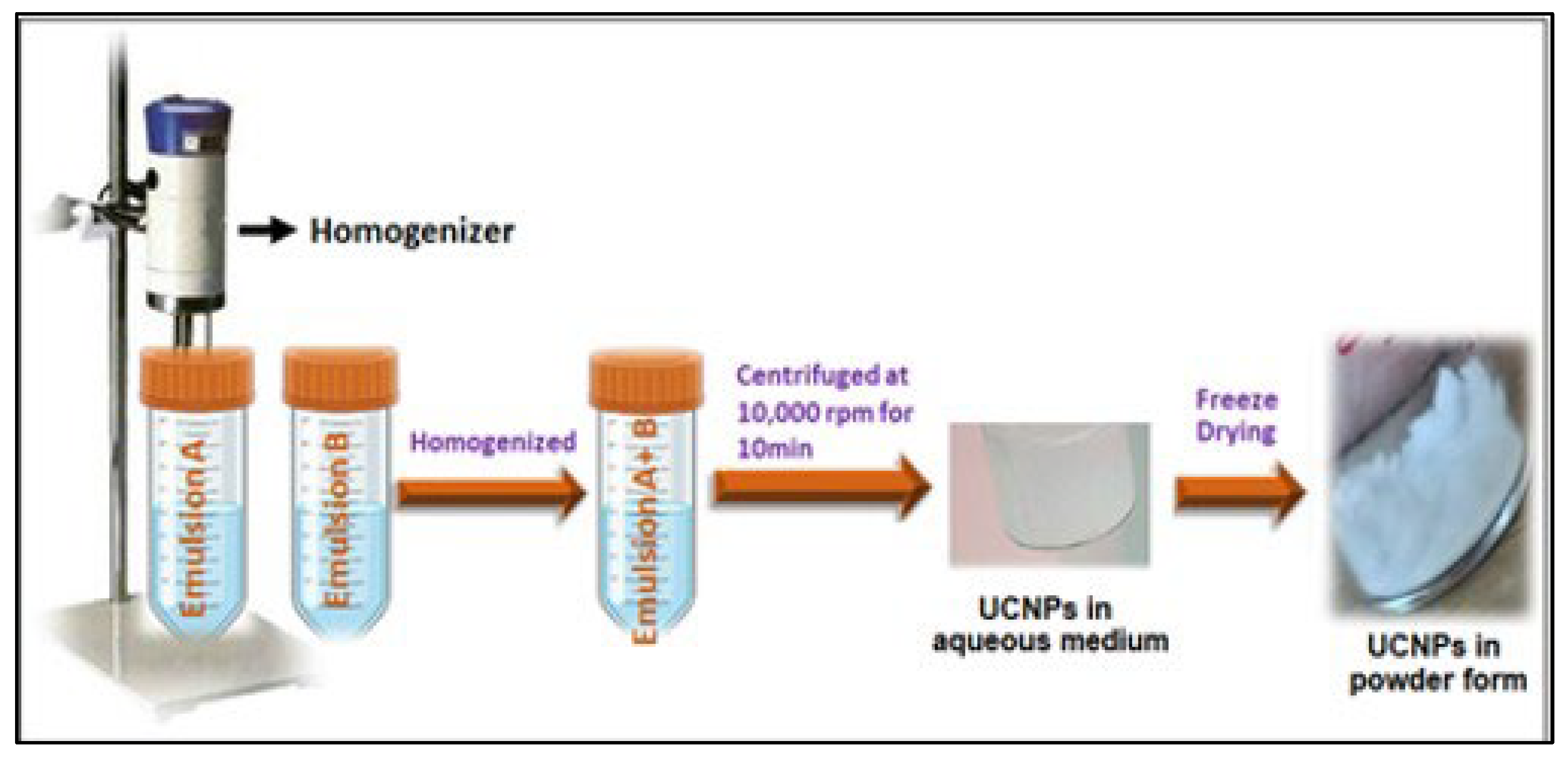
| Sr. No. | Host Material | Dopant | Ratio | Emission | Synthesis Method | Laser Power | Stabilizing/Capping Agent | Reference |
|---|---|---|---|---|---|---|---|---|
| 1. | CaF2 | Yb, Er, Mn | 15%, 2%, (0, 0.7, 2.6, 4.7, 6 and 7) | Red and green varied upon Mn concentration | In situ hydrothermal condition | - | - | [31] |
| 2 | CaF2 | Yb, Er | 20%, 2% | Green and red | One pot hydrothermal | - | Oleate ions | [32] |
| 3 | CaF2 | Er | 0.05–1% | Red and green | Temperature gradient method | - | - | [33] |
| 4 | CaF2 | Yb/Er | 20%, 2% | Red and green | Hydrothermal, coprecipitation, and decomposition | 10–80 W cm−2 | Tri-sodium citrate | [34] |
| 5 | LiYF4 | Yb, Er | 3%, 0.025% | Green (temp tuned) | Thermal decomposition | 65–250 W cm−2 | Cysteine | [35] |
| 6 | NaYF4 | Yb, Er | 20%, 2% | Strong Blue and Red | PVP-assisted method | 1300 W | PVP | [36] |
| 7 | NaYF4 | Yb, Er | (20–100%), 2% | Green and red | Thermal decomposition | 7 W cm−2 and 50 mW mm−2 | Oleate | [37] |
| 8 | NaYF4 | Yb, Er, and Nd | 20, 2, 10 | Green and red | Thermal decomposition | 13 W cm−2 | - | [38] |
| 9 | CaF2 | Yb, Er | 20%, (2%, 2.5%, 3% and 5%) | Red and green (red dominant) | Miniemulsion-mediated coprecipitation method | 0.28 W–0.7 W | - | This work |
Disclaimer/Publisher’s Note: The statements, opinions and data contained in all publications are solely those of the individual author(s) and contributor(s) and not of MDPI and/or the editor(s). MDPI and/or the editor(s) disclaim responsibility for any injury to people or property resulting from any ideas, methods, instructions or products referred to in the content. |
© 2024 by the authors. Licensee MDPI, Basel, Switzerland. This article is an open access article distributed under the terms and conditions of the Creative Commons Attribution (CC BY) license (https://creativecommons.org/licenses/by/4.0/).
Share and Cite
Dubey, N.; Gupta, S.; Shelar, S.B.; Barick, K.C.; Chandra, S. Maximizing Upconversion Luminescence of Co-Doped CaF₂:Yb, Er Nanoparticles at Low Laser Power for Efficient Cellular Imaging. Molecules 2024, 29, 4177. https://doi.org/10.3390/molecules29174177
Dubey N, Gupta S, Shelar SB, Barick KC, Chandra S. Maximizing Upconversion Luminescence of Co-Doped CaF₂:Yb, Er Nanoparticles at Low Laser Power for Efficient Cellular Imaging. Molecules. 2024; 29(17):4177. https://doi.org/10.3390/molecules29174177
Chicago/Turabian StyleDubey, Neha, Sonali Gupta, Sandeep B. Shelar, K. C. Barick, and Sudeshna Chandra. 2024. "Maximizing Upconversion Luminescence of Co-Doped CaF₂:Yb, Er Nanoparticles at Low Laser Power for Efficient Cellular Imaging" Molecules 29, no. 17: 4177. https://doi.org/10.3390/molecules29174177






